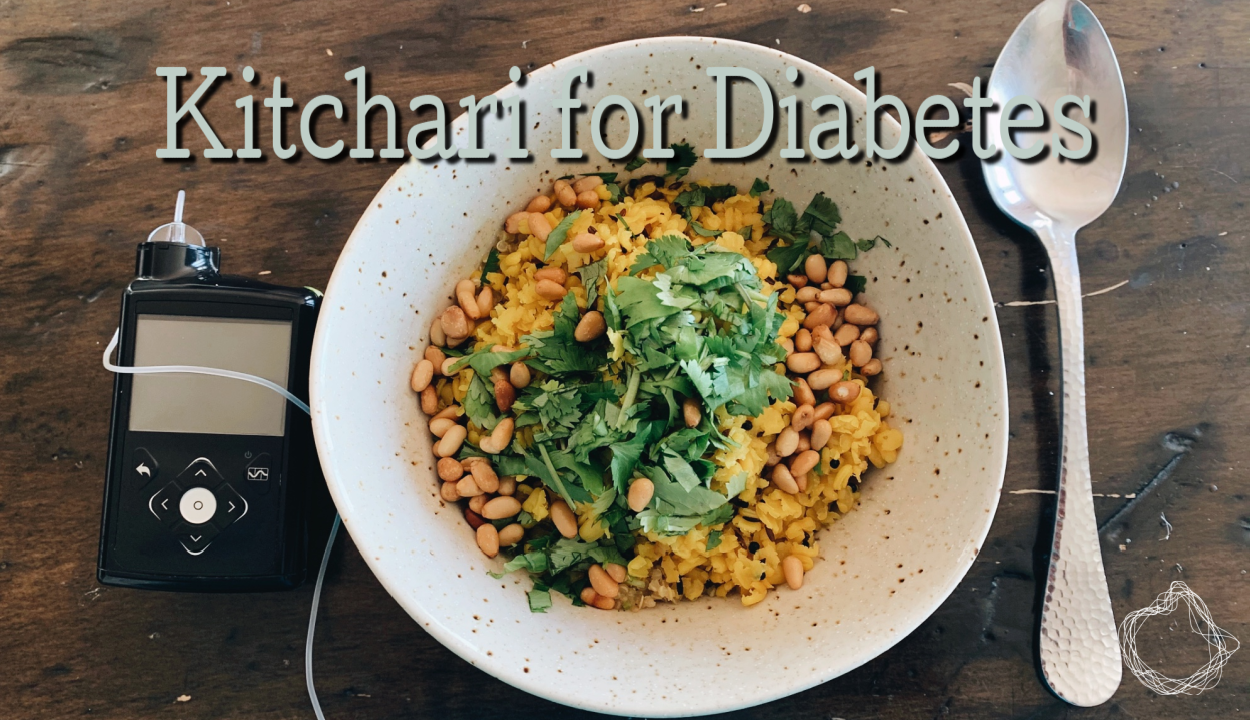Kitchari Recipe for DiabetesKitchari is a healthy and soothing dish frequently prescribed by Ayurvedic specialists to restore digestion by increasing agni, our digestive fire. Important to restore and maintain gut balance. However, kitchari can be challenging for people with diabetes to digest because of its high carbohydrate density and the fact that it is made in large batches, making it more difficult to dose appropriately with insulin.
I love kitchari and believe in its medicinal qualities as a reset for my gut or when I need nourishment. I have come up with two adaptations for people with diabetes of a classic kitchari recipe adapted from Vasant and Usha Lad’s Ayurvedic Cooking for Self-Healing. The first is for people who are carbohydrate friendly, and the second for those who wish to reduce their carbohydrate intake. I have chosen quinoa as the grain in the first recipe instead of the classic rice kitchari recipe. The second recipe can present challenges if a person is eating kitchari to reduce gas and bloating, as it contains cauliflower. Why this recipe works for diabetes: Vata derangement is a product of type 1 diabetes. This recipe specifically helps to reduce excessive vata. Excessive kapha is also commonly associated with type 2 diabetes imbalances. Kitchari is reducing and balancing. Good for all doshas. Instead of cooking the dal and grain together as it is done in the classic recipe, I make them separately, joining them when it is time to eat to help measure carbohydrate content. I recommend creating the recipe in an app like MyFitnessPal and even measure the weight of the dal post cooking without liquid (if you want to get really specific) to know the exact portion size. This recipe is high carb but low fat so it should not require a dual-wave bolus. Type 1's be sure to pre-bolus at least 10 minutes to avoid a post-prandial spike. RECIPE 1: KITCHARI WITH GRAIN Servings: 4 This is a more classic recipe for kitchari. The adaptation is to cook the dal and the grain separately. This way you can measure the carbohydrates for your meal with greater ease and flexibility. I choose to use quinoa, as it is a complex carbohydrate. Mung Dal 1 cup yellow split mung dal, rinsed and soaked for at least 4 hours. 2-3 tbsp ghee or high-quality oil (not coconut, as it increases vāta) 2 tsp cumin seeds 2 tsp black mustard seeds Pinch of hing 1 tsp turmeric 3-4 cup water 1 light tsp salt 2 c veggies of choice. I like carrots! Cilantro as desired Quinoa 1 cup white quinoa 1 3⁄4 cup water Rinse the quinoa and mung dal. Soak the mung dal for at least 4 hours to help with digestion. In a small pot, heat up the ghee on medium, and toss in the cumin, mustard seeds, and hing. When they start to pop, add in the dal and turmeric, and stir. Add the 3 cups of water, root veggies and bring to a boil for 5 minutes and then cover slightly and reduce to simmer for about 20-30 minutes depending on how long you've pre-soaked the dal. Keep an eye out that the dal does not dry out, adding more water as necessary. If you're adding high water content veggies like zucchini, add in the last 10 minutes of cooking. Once cooked, add salt and garnish with cilantro. In the meantime, make the quinoa. Bring it to a boil, cover and bring heat to a simmer for 15 minutes. I personally like to use a ratio of grain to water of less than 1:2. Try it out. Once finished, take quinoa off the heat, place a paper towel under the lid and wait at least 5 minutes. This absorbs any extra water and makes the quinoa fluffy. RECIPE 2: CAULIFLOWER KITCHARI Follow the same steps and ingredients for the dal in recipe 1 except for the quinoa. In the last ten minutes of cooking, add about 2–3 cups of cauliflower rice and another cup of water if it looks dry.
1 Comment
Frances Ann
12/23/2020 09:15:43 am
Thanks for the recipe comparison and explanation.
Reply
Leave a Reply. |
AuthorEvan Rachel Soroka Archives
November 2021
Categories |
220 West Main St. Unit 202, Aspen, CO 81611 CONTACT 970-618-9042 © COPYRIGHT SOROKA YOGA THERAPY 2021. ALL RIGHTS RESERVED.


 RSS Feed
RSS Feed